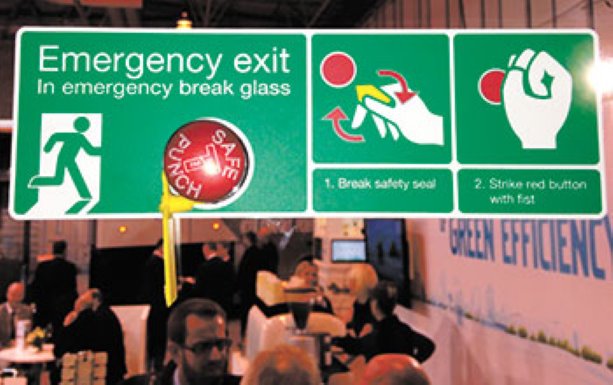A simple device widely used in parts of Africa and the U.K. could help B.C. construction contractors meet WorkSafeBC regulations concerning secondary escape hatches on heavy equipment.
The Safe T Punch is a red button that clings to windows.
A tab is pulled, the button is pushed and the window shatters outwards.
WorkSafeBC occupational health and safety regulations state that mobile equipment manufactured after Jan. 1, 2000 must include an alternate means of escape from the cab.
The button is being called a simple solution that some hope will save time, money and, most importantly, lives in B.C.’s construction industry.
“It’s quite elegant. You simply punch it and the glass breaks,” said Mike McKenna, executive director for B.C. Construction Safety Alliance.
The product is already extensively used on buses in parts of Africa and the U.K.
Some construction industry leaders are calling on WorkSafeBC to accept the buttons for its secondary escape requirement.
“It just looks like such a simple solution,” McKenna said.
McKenna said he’s impressed that the buttons offer quick access to a worker in distress from inside or outside the cab.
Chris Cheney is the Wajax sales manager in the B.C. region and the product’s distributor in the province.
He said he’s only started seeing enforcement of the regulation in the past few years and some clients weren’t even aware it existed.
He said this sent the industry scrambling to find solutions.
Cheney said modifying or designing equipment to add extra doors or hatches is an expensive undertaking.
“They are all different. Some are fairly easy to do and some are near impossible to do,” he said.
“Any machine can be modified, it just comes down to how much money and time you want to throw at it.”
And since some heavy equipment manufacturers and suppliers only sell a few units in B.C., the only region with the regulation, designing a separate model for the province wouldn’t be worth it, he added.
Cheney said some estimates have gone as high as $500,000 for a retrofit.
So, he posed the problem to Bell Equipment out of South Africa.
Its engineers came back with the Safe T Punch, a product that was developed roughly 20 years ago.
In the past decade, it has been adopted by established bus brands like Daimler, Scania and Alexander Dennis.
When the button is punched, a bevelled tungsten tip perforates the compression layer of toughened glass.
Cheney said it takes around 18 foot pounds of pressure to operate.
The design also makes it possible to break the glass window with multiple softer blows.
Cheney said it isn’t just about reducing costs.
He cited some advantages to the button over added doors or hatches.
Their use doesn’t vary from machine to machine, they can be operated quickly and can be used underwater far easier than a door.
Jack Davidson of the B.C. Road Builders and Heavy Construction Association said the Safe T Punch is already being used in some vehicles, but discussions on its full adoption are still ongoing.
Davidson said one of the concerns officials have is the danger tempered glass poses after being broken.
McKenna said WorkSafeBC appears to be leaning towards using the buttons as last resort option if redesigns or retrofits aren’t feasible.
Meanwhile, McKenna said, the industry would like to see its use come to the forefront.
As for the glass concerns, McKenna, Cheney and Davidson feel cuts or scrapes sustained from the cubes of broken tempered glass is an acceptable risk.
“Do you want a good looking corpse, or do want a living, breathing guy?” McKenna asked.
A Safe T Punch demo for WorkSafeBC officials and engineers has been tentatively scheduled for the end of June.



Recent Comments
comments for this post are closed